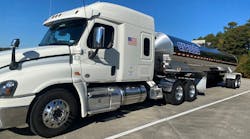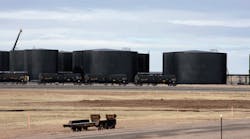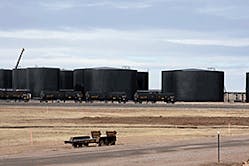The United States and Canada simultaneously announced new rules on May 1 that are intended to improve accident prevention, mitigation, and emergency response for rail shipments of crude oil and other flammable liquids. Several major rail accidents in the United States and Canada over the last several years helped lead to calls for more stringent oversight of hazmat shipments by rail.
Developed by the Pipeline and Hazardous Materials Safety Administration (PHMSA) and Federal Railroad Administration (FRA), in coordination with Canadian transportation agencies, the new rules focus enhanced tankcar standard and an aggressive, risk-based retrofitting schedule for older tankcars carrying crude oil and ethanol. The rules require a new braking standard for certain trains that federal officials say they believe will offer a superior level of safety by potentially reducing the severity of an accident, and the “pile-up effect.”
“Safety has been our top priority at every step in the process for finalizing this rule, which is a significant improvement over the current regulations and requirements and will make transporting flammable liquids safer,” Anthony Foxx, US transportation secretary, said during the announcement of the final rule. “Our close collaboration with Canada on new tankcar standards is recognition that the trains moving unprecedented amounts of crude by rail are not US or Canadian tankcars--they are part of a North American fleet and a shared safety challenge.”
Lisa Raitt, Canada’s minister of transport, added: “This stronger, safer, more robust tankcar will protect communities on both sides of our shared border. Through strong collaboration we have developed a harmonized solution for North America’s tank car fleet. I am hopeful that this kind of cooperation will be a model for future Canada-US partnership on transportation issues.”
Other US federal agencies seem to see the new rules as fresh opportunities to launch their own attacks on the shale oil sector. The Department of Homeland Security (DHS), including the Federal Emergency Management Agency (FEMA), the Environmental Protection Agency (EPA), and the Department of Energy (DOE), in coordination with the White House, are pursuing strategies under the guise of “safety.” DOE recently developed an initiative designed to research and characterize tight and conventional crude oils based on key chemical and physical properties, and to identify properties that may contribute to increased likelihood and/or severity of combustion events that can arise during handling and transport.
DOE’s attack on shale oil has already drawn harsh criticism from the oil industry. Not surprisingly, the industry reacted guardedly to the new rail transport rules.
"As we review these rules, the key question is whether science and data show each change will make a meaningful improvement to safety," said Jack Gerard, American Petroleum Institute president and chief executive officer. "A thoughtful, comprehensive and data-driven safety approach is critical to improving on the 99.997% safety record of freight rail to reach our goal of zero accidents.
"Tankcars and the industry's work to educate first responders are two elements of the bigger picture. Accident investigations consistently show that more must also be done to prevent derailments by enhancing the inspection and maintenance of train tracks, axles, and other railroad equipment.
API suggested that inclusion of a requirement for electronically controlled pneumatic (ECP) brakes will add to the artificial constraints created by a timeline for retrofitting the existing tankcar fleet that does not fully account for limited shop capacity available to complete the work.
"The safety impact of ECP brakes is marginal at best," Gerard said. "It is concerning that regulators did not select one of several alternative braking technologies that have much clearer benefits for safety.
"We support upgrades to the tank car fleet and want them completed as quickly as realistically possible. The railcar manufacturing industry's own calculations show it does not have the shop capacity to meet the retrofit timeline announced today, which will lead to shortages that impact consumers and the broader economy."
This final rule represents the latest, and most significant to date, in a series of nearly 30 actions that DOT has initiated over the last 19 months, including additional emergency orders, safety advisories, and other actions. (Unless stated otherwise, the rule applies to “high-hazard flammable trains” (HHFTs)—a continuous block of 20 or more tank cars loaded with a flammable liquid or 35 or more tank cars loaded with a flammable liquid dispersed through a train).
Enhanced Standards for New and Existing Tank Cars for use in an HHFT—New tank cars constructed after October 1, 2015, are required to meet the new DOT Specification 117 design or performance criteria. The prescribed car has a 9/16 inch tank shell, 11-gauge jacket, half-inch full-height head shield, thermal protection, and improved pressure relief valves and bottom outlet valves. Existing tankcars must be retrofitted with the same key components based on a prescriptive, risk-based retrofit schedule. As a result of the aggressive, risk-based approach, the final rule will require replacing the entire fleet of DOT-111 tankcars for Packing Group I, which covers most crude shipped by rail, within three years and all non-jacketed CPC-1232s, in the same service, within approximately five years.
Enhanced Braking to Mitigate Damage in Derailments—The rule requires HHFTs to have in place a functioning two-way end-of-train (EOT) device or a distributed power (DP) braking system. Trains meeting the definition of a “high-hazard flammable unit train,” or HHFUT (a single train with 70 or more tankcars loaded with Class 3 flammable liquids), with at least one tank car with Packing Group I materials, must be operated with an electronically controlled pneumatic (ECP) braking system by January 1, 2021. All other HHFUTs must have ECP braking systems installed after 2023. DOT claims this technology has been operated successfully for years in certain services in the United States, Australia, and elsewhere.
Reduced Operating Speeds—The rule restricts all HHFTs to 50 mph in all areas and HHFTs containing any tank cars not meeting the enhanced tankcar standards required by this rule are restricted to operating at a 40 mph speed restriction in high-threat urban areas. The 40 mph restriction for HHFTs without new or retrofitted tank cars is also currently required under FRA’s Emergency Order No. 30.
Rail Routing--More Robust Risk Assessment—Railroads operating HHFTs must perform a routing analysis that considers, at a minimum, 27 safety and security factors, including “track type, class, and maintenance schedule” and “track grade and curvature,” and select a route based on its findings. These planning requirements are prescribed in 49 CFR §172.820.
Rail Routing--Improves Information Sharing—Ensures that railroads provide State and/or regional fusion centers, and State, local, and tribal officials with a railroad point of contact for information related to the routing of hazardous materials through their jurisdictions. This replaces the proposed requirement for railroads to notify State Emergency Response Commissions (SERCs) or other appropriate state-designated entities about the operation of these trains through their States.
More Accurate Classification of Unrefined Petroleum-Based Products—Offerors must develop and carry out sampling and testing programs for all unrefined petroleum-based products, such as crude oil, to address the criteria and frequency of sampling to improve and ensure accuracy. Offerors must certify that hazardous materials subject to the program are packaged in accordance with the test results, document the testing and sampling program outcomes, and make that information available to DOT personnel upon request.
For additional information on the steps the Department of Transportation has already taken to help strengthen the safe transport of crude oil by rail, please visit www.dot.gov/mission/safety/rail-chronology.










